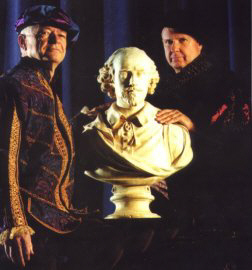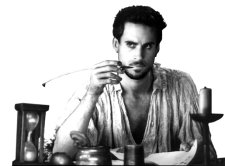Professors in Love with Shakespeare

By Leslie Weddell
he Bard is back -- big time. In fact, the Bard is a blockbuster.
And Colorado College Professors John Simons and Mark Stavig couldn't be happier. The English professors, who teach "Shakespeare on Film," have long known how well-suited much of Shakespeare's work is to the big screen.
Their innovative class comes at a time when Shakespeare is not only in love, but so are the movie-going public, Hollywood filmmakers, and Academy Award judges.
"Elizabeth," the story of the English monarch who ruled in Shakespeare's day, and "Shakespeare in Love," Marc Norman and Tom Stoppard's bittersweet comedy of the muse behind Shakespeare's genius, combined for a total of 20 nominations at the 71st Academy Awards in Hollywood. The films competed against each other in six categories, including best film, best actress in a leading role, art direction, cinematography, costume design, and makeup. "Shakespeare in Love" came away with seven Oscars, including best film, and "Elizabeth" took the best makeup award.
Both films also did well at the British Academy Film Awards, held in April.
"Shakespeare in Love" won best film and three other awards; Elizabeth took five honors, including the best actress award for Cate Blanchett.
If all this seems improbable fiction to you, clearly it's time to brush up on your Shakespeare. And that's exactly what Simons and Stavig helped a group of Seattle-area alumni do last summer.
The two presented an evening of Shakespeare at the lakeside home of Doug '62 and Nancy Pettit '64 Norberg -- an appropriate setting, given that Norberg has been instrumental in restoring theaters in downtown Seattle. Simons and Stavig set up a television and presented a condensed roadtrip version of their course to Seattle alumni. "We started with a scene from Ian McKellen's "Richard III." It has a real Clint Eastwood-kind of beginning, one that shows how the best Shakespearean productions always have a way of touching contemporary experience."
As Bill Gates' mansion twinkled in the dusk across the lake, Simons and Stavig kept asking, "Have you had enough yet?" The living room crowd wanted more.
They aren't the only ones who are demanding more Shakespeare -- the Bard is a box-office smash. How could the story lines written by a man 400 years ago appeal to a techno-savvy audience on the verge of a new millennium? Ay, there's the rub.
Neither Stavig nor Simons expected "Shakespeare in Love" to become the commercial success that it has. Stavig went to see the film soon after it opened and was amazed to see so many people he knew in the audience.
Stavig calls the Norman and Stoppard screenplay "brilliant," chock full of clever touches. And although it contains farcical and comical elements, as well as inside jokes and allusions to other works, one need not be a Shakespeare specialist to appreciate the film.
Not every viewer, for example, knew that Johnny, the boy who hung around the theater and had an inordinate interest in gore and carnage, was young John Webster, a man who 20 years later would write some of the bloodiest tragedies in the English language. "It's things like that the Shakespeare scholars loved," Stavig says.
"Stoppard has a great ear for language, and he gets inside the mind of a genius like Shakespeare very nicely," adds Simons.

Joseph Fiennes, they agree, was well cast as the lead. His long, gaunt face and starving-artist look made him a believable Shakespeare. Both were "flat out rooting" for "Shakespeare in Love" to win at the Academy Awards. It was, for them, such stuff as dreams are made on.
Laurence Olivier really got people thinking about putting Shakespeare on the screen in new and innovative ways, the CC scholars say. "Olivier saw Shakespeare as a cinematic experience, not just a transcription to film," says Simons, who points out how the camera is in constant motion in "Hamlet," tracking shots through the intricacies of the castle at Elsinore.
The two credit Franco Zeffirelli for tapping into the youth movement and the social turmoil of the times with his1968 version of "Romeo and Juliet." That movie, which received four Oscar nominations, marked the first time young and old flocked to the theaters to see a Shakespearean film. That crossover, says Simons, is key to a film's commercial success.
But Kenneth Branagh, they say, is the youthful energy who set the second renaissance of Shakespearean films in motion.
"Branagh's respect for Shakespeare is as great as his respect for film. He is a master at bringing Shakespeare to popular audiences," says Simons.
In class, the students read the plays, then see how various filmmakers interpret Shakespeare. "Once you've seen a film, the cinematic version always overwhelms the written text," Simons says. Viewers may strive mightily to rid themselves of the film's images, but it's difficult. "It can't be helped. A film is more human -- and it's the primary medium for the generation now in college."
Stavig and Simons show a trio of films of "Hamlet": Olivier's 1948 version starring Olivier and Eileen Herlie; Zeffirelli's 1990 version with Mel Gibson and Glenn Close; and Branagh's 1996 version with Branagh and Julie Christie.
Much of the viewer's interpretation depends on the depiction of Hamlet and his mother. In Branagh's film, Julie Christie is obviously an older, more mature woman. In Zeffirelli's version, Mel Gibson and Glenn are much closer in age. As the age of the actors affects one's interpretation, so does the way certain scenes are portrayed. The depiction of the ghost, for example, underscores the level of realism or surrealism in the film.
The CC professors also teach Shakespeare's remarkable "translatability" to other cultures, screening Akira Kurosawa's great rendition of "Macbeth," "Throne of Blood," as well as his version of "King Lear." "Shakespeare knows no borders or age limits," says Simons. "We met a young grade-school teacher in Seattle who has his elementary kids doing full-length Shakespeare plays. It's never too early to enjoy the Bard."
Stavig, the renaissance scholar, enjoys the cultural and historical questions of Shakespeare. Simons, a film studies expert, enjoys analyzing the structural and psychological elements of the plays. They may seem like strange bedfellows, the two have compatible dispositions, though differing philosophies and viewpoints.
Not surprisingly then, the two have different best flick picks. Stavig likes Branagh's "Hamlet" for its historical elements; Simons prefers the Olivier film for its exploration of the labyrinth of the human mind. "Elizabeth," they agree, plays too loosely with historical facts.
And the students? "They prefer the more recent films, particularly the Branagh films, with the rapid cuts between scenes. That's how their eyes are trained," says Simons.
And what of tomorrow, and tomorrow and tomorrow? "Money follows money," they say. Must be so -- theater-goers can look forward to seeing Michelle Pfeiffer and Kevin Kline in Shakespeare's "A Midsummer Night's Dream" later this year.
Can one desire too much of a good thing?
With apologies to the Bard:
Improbable fiction (Twelfth Night); Ay, there's the rub (Hamlet); Such stuff as dreams are made on (The Tempest); Strive mightily (The Taming of the Shrew); Strange bedfellows (The Tempest); Tomorrow, and tomorrow and tomorrow (Macbeth); Can one desire too much of a good thing? (As You Like It)Back to Index